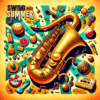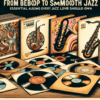Timeless Tunes: The 10 Best Jazz Albums That Shaped Music History

Jazz music is a genre that has constantly evolved, but certain albums have become cornerstones of its rich history. These records not only showcase remarkable musical talent but also reflect significant cultural and social movements, influencing countless other genres along the way. In this article, we explore ten of the most pivotal jazz albums that have left an indelible mark on music history.
- 1. Miles Davis – "Kind of Blue" (1959)
- 2. John Coltrane – "A Love Supreme" (1965)
- 3. Duke Ellington – "Ellington at Newport" (1956)
- 4. Charles Mingus – "Mingus Ah Um" (1959)
- 5. The Dave Brubeck Quartet – "Time Out" (1959)
- 6. Herbie Hancock – "Head Hunters" (1973)
- 7. Billie Holiday – "Lady in Satin" (1958)
- 8. Ornette Coleman – "The Shape of Jazz to Come" (1959)
- 9. Ella Fitzgerald and Louis Armstrong – "Ella and Louis" (1956)
- 10. Weather Report – "Heavy Weather" (1977)
- Conclusion: The Enduring Legacy of Timeless Tunes
- FAQs
1. Miles Davis – "Kind of Blue" (1959)
Miles Davis's "Kind of Blue" is often regarded as the pinnacle of jazz innovation. This album introduced the modal jazz concept, moving away from the traditional chord-based structure. With an impeccable lineup including John Coltrane and Bill Evans, the album's improvisational brilliance and emotional depth continue to resonate with listeners, influencing generations of musicians.
2. John Coltrane – "A Love Supreme" (1965)
"A Love Supreme" is a spiritual suite reflecting Coltrane's deep faith and personal journey. The album showcases Coltrane's mastery of the saxophone and his exploration of avant-garde jazz. Its intricate rhythms and transcendent themes make it a monumental work that is often cited as one of the greatest jazz albums of all time.
3. Duke Ellington – "Ellington at Newport" (1956)
Duke Ellington's live performance at the Newport Jazz Festival revitalized his career and solidified his place in jazz history. The album features a blend of classic compositions and new material, alongside an electrifying solo by tenor saxophonist Paul Gonsalves. This recording is a testament to Ellington’s genius and to the dynamic power of live jazz.
4. Charles Mingus – "Mingus Ah Um" (1959)
See Also: Swing Into Summer: Top 10 Jazz Festivals You Can't Miss in 2025
Swing Into Summer: Top 10 Jazz Festivals You Can't Miss in 2025"Mingus Ah Um" stands as Charles Mingus's magnum opus. This album fuses various styles, from blues to gospel, while showcasing Mingus's powerful compositions and intricate arrangements. Every track tells a story, making it a reflection of the social and racial issues of its time. The album is a powerful statement, rich in emotion and complexity.
5. The Dave Brubeck Quartet – "Time Out" (1959)
Breaking conventional time signatures, "Time Out" introduced jazz enthusiasts to a new world of rhythmic exploration. Featuring the iconic track "Take Five," the album elevated jazz to new artistic heights. Brubeck’s innovative approach and the quartet's chemistry created a landmark recording that remains a favorite among both jazz novices and connoisseurs.
6. Herbie Hancock – "Head Hunters" (1973)
"Head Hunters" is a groundbreaking album that merged jazz with funk, opening the doors to jazz fusion. With its infectious rhythms and electronic experimentation, this record not only set the stage for future jazz directions but also appealed to a broader audience, bringing jazz into the mainstream embrace of popular music.
7. Billie Holiday – "Lady in Satin" (1958)
Billie Holiday's poignant and soulful voice is at its most vulnerable on "Lady in Satin." This late-career masterpiece finds Holiday reflecting on love, loss, and heartache, emphasized by lush orchestral arrangements. It remains a moving testament to her artistry and lasting influence on vocal jazz.
8. Ornette Coleman – "The Shape of Jazz to Come" (1959)
Ornette Coleman's "The Shape of Jazz to Come" ushered in the free jazz movement, challenging existing musical norms. The album breaks away from traditional chord progressions, allowing musicians to explore innovative improvisational techniques. Coleman's visionary approach opened up new possibilities for future generations of jazz musicians.
See Also: Soothe Your Soul: The Allure of Smooth Jazz Tunes
Soothe Your Soul: The Allure of Smooth Jazz Tunes9. Ella Fitzgerald and Louis Armstrong – "Ella and Louis" (1956)
The album "Ella and Louis" captures the enchanting chemistry between two of jazz's most iconic figures. Their vocal interplay and joyful delivery create a timeless experience, showcasing standards that have become jazz classics. This collaboration remains a benchmark for vocal jazz and continues to inspire artists today.
10. Weather Report – "Heavy Weather" (1977)
"Heavy Weather," featuring the infamous "Birdland," embodies the zenith of jazz fusion. Weather Report's revolutionary mixture of electric instruments and improvisational prowess created a unique sound that appealed to diverse audiences. The album signifies the genre's evolution and exemplifies the limitless possibilities of jazz.
Conclusion: The Enduring Legacy of Timeless Tunes
The ten albums discussed represent more than just music; they are historical artifacts that encapsulate the spirit of their times. From the profound melancholy of Billie Holiday to the avant-garde exploration of Ornette Coleman, these recordings reflect cultural shifts and personal stories that resonate deeply within the human experience. They have not only shaped the evolution of jazz but also influenced a multitude of other genres, demonstrating jazz's versatility and timelessness.
As we continue to explore the vast world of jazz, it's essential to acknowledge its roots and the timeless tunes that shaped its narrative. These albums serve as a reminder of the power of music to transcend barriers, provoke thought, and evoke emotion. For anyone looking to immerse themselves in the world of jazz, these ten albums are the perfect starting point, each offering a unique perspective on a genre that is as dynamic and vibrant as the world it reflects.
FAQs
See Also: From Bebop to Smooth Jazz: Essential Albums Every Jazz Lover Should Own
From Bebop to Smooth Jazz: Essential Albums Every Jazz Lover Should Own1. What is jazz music?
Jazz is a genre of music that originated in the African American communities of New Orleans in the late 19th and early 20th centuries. It is characterized by swing and blue notes, call and response vocals, polyrhythms, and improvisation.
2. Why are these albums considered the best in jazz history?
These albums are considered the best in jazz history due to their innovative approaches to musical composition, groundbreaking techniques, and profound impact on both jazz and popular music. They each showcase the unique artistry of their creators, influencing countless musicians and genres.
3. How has jazz evolved over the years?
Jazz has evolved through various movements and styles, including swing, bebop, cool jazz, and jazz fusion. Each era has introduced new techniques, instruments, and cultural reflections, making jazz a continuously evolving art form.
4. Who are some other notable jazz artists worth exploring?
In addition to those mentioned, other notable jazz artists include Thelonious Monk, Sarah Vaughan, Chet Baker, Stan Getz, and Nina Simone. Exploring their work can provide a richer understanding of the diverse landscape of jazz music.
5. Where can I listen to these albums?
See Also: Sax, Piano, and Beyond: A Definitive List of Classic Jazz Albums You Can't Miss
Sax, Piano, and Beyond: A Definitive List of Classic Jazz Albums You Can't MissMost of these albums are available on popular music streaming platforms like Spotify, Apple Music, and YouTube. Many are also available for purchase as vinyl records, CDs, or digital downloads from various music retailers.
If you want to know other articles similar to Timeless Tunes: The 10 Best Jazz Albums That Shaped Music History you can visit the category Jazz.
